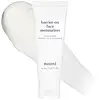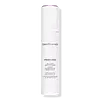What's inside
What's inside
 Key Ingredients
Key Ingredients

 Benefits
Benefits

 Concerns
Concerns

 Ingredients Side-by-side
Ingredients Side-by-side

Water
Skin ConditioningCetearyl Alcohol
EmollientGlycerin
HumectantDipropylene Glycol
Humectant1,2-Hexanediol
Skin ConditioningHydrogenated Poly(C6-14 Olefin)
EmollientButyrospermum Parkii Butter
Skin ConditioningMethyl Trimethicone
Skin ConditioningDicaprylyl Ether
EmollientGlyceryl Stearate Se
EmulsifyingPalmitic Acid
EmollientC12-16 Alcohols
EmollientHydrogenated Lecithin
EmulsifyingBehenyl Alcohol
EmollientCeramide NP
Skin ConditioningStearic Acid
CleansingCetearyl Glucoside
EmulsifyingButylene Glycol
HumectantHydroxyacetophenone
AntioxidantEclipta Prostrata Leaf Extract
Skin ConditioningLaminaria Japonica Extract
Skin ProtectingEthylhexylglycerin
Skin ConditioningCholesterol
EmollientSodium Hyaluronate
HumectantFructooligosaccharides
HumectantLactobacillus Ferment
Skin ConditioningBeta-Glucan
Skin ConditioningAmmonium Acryloyldimethyltaurate/Vp Copolymer
Xanthan Gum
EmulsifyingRosa Canina Fruit Oil
EmollientHelianthus Annuus Seed Oil Unsaponifiables
EmollientCamellia Sinensis Flower Extract
PerfumingHydrolyzed Hyaluronic Acid
HumectantMyristic Acid
CleansingCetearyl Olivate
Glucose
HumectantAvena Sativa Kernel Extract
AbrasiveSodium Benzoate
MaskingPotassium Sorbate
PreservativeCentella Asiatica Extract
CleansingFicus Carica Fruit Extract
HumectantSorbitan Olivate
EmulsifyingTocopherol
AntioxidantWater, Cetearyl Alcohol, Glycerin, Dipropylene Glycol, 1,2-Hexanediol, Hydrogenated Poly(C6-14 Olefin), Butyrospermum Parkii Butter, Methyl Trimethicone, Dicaprylyl Ether, Glyceryl Stearate Se, Palmitic Acid, C12-16 Alcohols, Hydrogenated Lecithin, Behenyl Alcohol, Ceramide NP, Stearic Acid, Cetearyl Glucoside, Butylene Glycol, Hydroxyacetophenone, Eclipta Prostrata Leaf Extract, Laminaria Japonica Extract, Ethylhexylglycerin, Cholesterol, Sodium Hyaluronate, Fructooligosaccharides, Lactobacillus Ferment, Beta-Glucan, Ammonium Acryloyldimethyltaurate/Vp Copolymer, Xanthan Gum, Rosa Canina Fruit Oil, Helianthus Annuus Seed Oil Unsaponifiables, Camellia Sinensis Flower Extract, Hydrolyzed Hyaluronic Acid, Myristic Acid, Cetearyl Olivate, Glucose, Avena Sativa Kernel Extract, Sodium Benzoate, Potassium Sorbate, Centella Asiatica Extract, Ficus Carica Fruit Extract, Sorbitan Olivate, Tocopherol
Water
Skin ConditioningButylene Glycol
HumectantDipropylene Glycol
HumectantGlycerin
HumectantHydrogenated Polydecene
EmollientTriethylhexanoin
MaskingHdi/Trimethylol Hexyllactone Crosspolymer
Dimethicone
EmollientDipeptide-15
Skin ConditioningGlyceryl Stearate Se
EmulsifyingTrehalose
HumectantTocopherol
AntioxidantSaccharum Officinarum Extract
MoisturisingCitrus Aurantium Dulcis Fruit Extract
MaskingCitrus Limon Fruit Extract
MaskingSodium Hyaluronate
HumectantMorinda Citrifolia Leaf Extract
Skin ConditioningLeuconostoc/Radish Root Ferment Filtrate
AntimicrobialAcer Saccharum Extract
Skin ConditioningVaccinium Myrtillus Fruit Extract
Skin ConditioningSalvia Hispanica Seed Extract
EmollientGluconolactone
Skin ConditioningChondrus Crispus Extract
Skin ConditioningAminopropyl Dimethicone
Betaine
HumectantSodium Metabisulfite
AntioxidantIsostearic Acid
CleansingCoconut Acid
CleansingPEG-5 Glyceryl Stearate
EmulsifyingBehenyl Alcohol
EmollientStearic Acid
CleansingCarbomer
Emulsion StabilisingXanthan Gum
EmulsifyingPotassium Hydroxide
BufferingBehenic Acid
CleansingSilica
AbrasiveDisodium EDTA
Sodium Benzoate
MaskingPhenoxyethanol
PreservativeWater, Butylene Glycol, Dipropylene Glycol, Glycerin, Hydrogenated Polydecene, Triethylhexanoin, Hdi/Trimethylol Hexyllactone Crosspolymer, Dimethicone, Dipeptide-15, Glyceryl Stearate Se, Trehalose, Tocopherol, Saccharum Officinarum Extract, Citrus Aurantium Dulcis Fruit Extract, Citrus Limon Fruit Extract, Sodium Hyaluronate, Morinda Citrifolia Leaf Extract, Leuconostoc/Radish Root Ferment Filtrate, Acer Saccharum Extract, Vaccinium Myrtillus Fruit Extract, Salvia Hispanica Seed Extract, Gluconolactone, Chondrus Crispus Extract, Aminopropyl Dimethicone, Betaine, Sodium Metabisulfite, Isostearic Acid, Coconut Acid, PEG-5 Glyceryl Stearate, Behenyl Alcohol, Stearic Acid, Carbomer, Xanthan Gum, Potassium Hydroxide, Behenic Acid, Silica, Disodium EDTA, Sodium Benzoate, Phenoxyethanol
 Reviews
Reviews

Ingredients Explained
These ingredients are found in both products.
Ingredients higher up in an ingredient list are typically present in a larger amount.
Behenyl Alcohol is a type of fatty alcohol (these are different from the drying, solvent alcohols).
Fatty Alcohols have hydrating properties and are most often used as an emollient or to thicken a product. They are usually derived from natural fats and oils; behenyl alcohol is derived from the fats of vegetable oils.
Emollients help keep your skin soft and hydrated by creating a film that traps moisture in.
In 2000, Behenyl Alcohol was approved by the US as medicine to reduce the duration of cold sores.
Learn more about Behenyl AlcoholButylene Glycol (or BG) is used within cosmetic products for a few different reasons:
Overall, Butylene Glycol is a safe and well-rounded ingredient that works well with other ingredients.
Though this ingredient works well with most skin types, some people with sensitive skin may experience a reaction such as allergic rashes, closed comedones, or itchiness.
Learn more about Butylene GlycolDipropylene Glycol is a synthetically created humectant, stabilizer, and solvent.
This ingredient helps:
Dipropylene glycol is technically an alcohol, but it belongs to the glycol family (often considered part of the ‘good’ alcohols). This means it is hydrating and gentle on skin unlike drying solvent alcohols like denatured alcohol.
As a masking agent, Dipropylene Glycol can be used to cover the smell of other ingredients. However, it does not have a scent.
Studies show Dipropylene Glycol is considered safe to use in skincare.
Learn more about Dipropylene GlycolGlycerin is already naturally found in your skin. It helps moisturize and protect your skin.
A study from 2016 found glycerin to be more effective as a humectant than AHAs and hyaluronic acid.
As a humectant, it helps the skin stay hydrated by pulling moisture to your skin. The low molecular weight of glycerin allows it to pull moisture into the deeper layers of your skin.
Hydrated skin improves your skin barrier; Your skin barrier helps protect against irritants and bacteria.
Glycerin has also been found to have antimicrobial and antiviral properties. Due to these properties, glycerin is often used in wound and burn treatments.
In cosmetics, glycerin is usually derived from plants such as soybean or palm. However, it can also be sourced from animals, such as tallow or animal fat.
This ingredient is organic, colorless, odorless, and non-toxic.
Glycerin is the name for this ingredient in American English. British English uses Glycerol/Glycerine.
Learn more about GlycerinGlyceryl Stearate Se is a self-emulsifying (SE) form of glyceryl stearate. Self-emusifying means this ingredient automatically blends with water. It is an emulsifier, emollient, and cleansing agent.
As an emulsifier, Glyceryl Stearate Se prevents ingredients such as oil and water from separating. It is also a surfactant, meaning it helps cleanse the skin. Surfactants help gather oil, dirt, and other pollutants so they may be rinsed away easily.
Emollients help your skin stay smooth and soft. It does so by creating a film on top of the skin that helps trap moisture in.
Learn more about Glyceryl Stearate SeSodium Benzoate is a preservative. It's used in both cosmetic and food products to inhibit the growth of mold and bacteria. It is typically produced synthetically.
Both the US FDA and EU Health Committee have approved the use of sodium benzoate. In the US, levels of 0.1% (of the total product) are allowed.
Sodium benzoate works as a preservative by inhibiting the growth of bacteria inside of cells. It prevents the cell from fermenting a type of sugar using an enzyme called phosphofructokinase.
It is the salt of benzoic acid. Foods containing sodium benzoate include soda, salad dressings, condiments, fruit juices, wines, and snack foods.
Studies for using ascorbic acid and sodium benzoate in cosmetics are lacking, especially in skincare routines with multiple steps.
We always recommend speaking with a professional, such as a dermatologist, if you have any concerns.
Learn more about Sodium BenzoateSodium Hyaluronate is hyaluronic acid's salt form. It is commonly derived from the sodium salt of hyaluronic acid.
Like hyaluronic acid, it is great at holding water and acts as a humectant. This makes it a great skin hydrating ingredient.
Sodium Hyaluronate is naturally occurring in our bodies and is mostly found in eye fluid and joints.
These are some other common types of Hyaluronic Acid:
Learn more about Sodium HyaluronateStearic Acid is a fatty acid. It is an emollient, emulsifier, and texture enhancer.
As an emollient, stearic acid helps soften skin. It aids the skin's protective barrier by preventing water loss. It also provides a gentle cleansing effect without stripping away natural oils.
Stearic acid may also be used to enhance the texture of products. It can add volume and stabilize ingredients such as water and oil. This can help water and oil ingredients from separating.
Sources of stearic acid include animal or vegetable fats/oils such as coconut or shea. It can be naturally found in butter, cocoa butter, shea butter, vegetable fats, and animal tallow.
This ingredient may not be Malassezia folliculitis, or fungal-acne safe.
Learn more about Stearic AcidTocopherol (also known as Vitamin E) is a common antioxidant used to help protect the skin from free-radicals and strengthen the skin barrier. It's also fat soluble - this means our skin is great at absorbing it.
Vitamin E also helps keep your natural skin lipids healthy. Your lipid skin barrier naturally consists of lipids, ceramides, and fatty acids. Vitamin E offers extra protection for your skin’s lipid barrier, keeping your skin healthy and nourished.
Another benefit is a bit of UV protection. Vitamin E helps reduce the damage caused by UVB rays. (It should not replace your sunscreen). Combining it with Vitamin C can decrease sunburned cells and hyperpigmentation after UV exposure.
You might have noticed Vitamin E + C often paired together. This is because it is great at stabilizing Vitamin C. Using the two together helps increase the effectiveness of both ingredients.
There are often claims that Vitamin E can reduce/prevent scarring, but these claims haven't been confirmed by scientific research.
Learn more about TocopherolWater. It's the most common cosmetic ingredient of all. You'll usually see it at the top of ingredient lists, meaning that it makes up the largest part of the product.
So why is it so popular? Water most often acts as a solvent - this means that it helps dissolve other ingredients into the formulation.
You'll also recognize water as that liquid we all need to stay alive. If you see this, drink a glass of water. Stay hydrated!
Learn more about WaterXanthan gum is used as a stabilizer and thickener within cosmetic products. It helps give products a sticky, thick feeling - preventing them from being too runny.
On the technical side of things, xanthan gum is a polysaccharide - a combination consisting of multiple sugar molecules bonded together.
Xanthan gum is a pretty common and great ingredient. It is a natural, non-toxic, non-irritating ingredient that is also commonly used in food products.
Learn more about Xanthan Gum